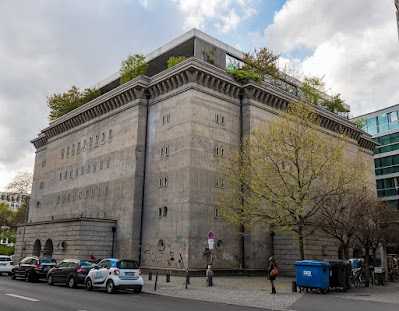 |
| Installation view on empty shelves of the public library |
German photographer Wolfgang Tillmans has been given carte blanche at the Pompidou Centre for a few months before the cultural mecca shuts down for five years of renovations. The simple activity of entering the Pompidou to visit this exhibition is a novel experience, even for those of us who are regulars. Visitors must cross the empty ground floor, walk up stairs, then take an escalator through a space not previously accessible to the public. On arrival at the second floor, having completed this unusual traversal of space, we enter the old public library. All other areas are boarded up. Even before I reached the entrance to Tillmans' exhibition, I was happy to be there.
 |
| Installation view |
I had taken my time to visit this exhibition because I am not a big Tillmans fan, but seeing so much of his work in one place — and in this space — was rewarding. Tillmans' photography is often not aesthetically pleasing, which is part of the point, and also, one of the reasons I am not always drawn in. That said, there are works that are highly aestheticized—particularly those in which he experiments with photographic materials and light. More often exhibited in France is Tillmans' vast collection of personal and public photographs resembling something like an amateur archive of images depicting his journey through a changing world. As a body of work, these photographs make visible every day life over the past fifty years.
 |
| Wolfgang Tillmans, Resolute Rave, 2020 |
I was surprised to see so many hip young people at the exhibition, because Tillmans' world is historical and presumably unknown to many of the visitors. Because Tillmans is my generation, his world is very familiar, and hence, I enjoyed seeing the breadth of his vision across decades. Under glass over five tables, Tillmans has curated photographs, programs, flyers, books from the past five decades. I spent a lot of time in Berlin in the 1990s and 2000s, and the immediate post-wall Berlin of Tillmans' generation was the same one that I skulked around in those years. The ecstasy nightclub scene, grunge living, and the freedom of a world seemingly without limits, in a united, undeveloped Berlin. It is a city that we will never know again in our lifetimes. Perusing Tillmans' photographs of Berlin in those years, I looked with nostalgia, and grateful to have been a part of during an extraordinary period in history.
 |
| Wolfgang Tillmans, Renzo Piano, 2024 |
Tillmans was given carte blanche to do as he wished, and perhaps the most interesting thing about the exhibition is that his installations are always in dialogue with the space. Whether it is a mirrored tabletop at which we peer and see the exposed pipes and ducts of the Pompidou ceiling, empty shelves of the one time library—the shelves of the arts and humanities being emptied while the scientific ones are filled with space travel books to indicate the state of knowledge today—a photograph of Renzo Piano in front of the building he designed, or photographs of the space we are in, Tillmans constantly reflects on the radical architecture of the Pompidou building.
 |
| Wolfgang Tillmans, Freischwimmer 234, 2024 |
Among Tillmans most stunning works are the Freischwimmer and Greifbar works - images that he makes using different light sources in the darkroom without a camera. Huge abstract works that look like ink dye playing on surfaces, and in some, creatures busily fanning across paper. The colours he finds through light play in the process of image production are sumptuous, always different. Similarly, the Silver works remind of carefully worked abstract paintings. Photographic paper is fed through used developer triggering chemical reactions. The resultant images are varied, appearing to be marked, blemished by the silver salts of the paper. Over time, we see that they are gorgeous, but enigmatic. And then, over time, their appearance as something that they are not, disappears.
%202011.jpeg) |
| Wolfgang Tillmans, Paper Drop (green), 2011 |
Lastly, a lot of fun was to be had by visitors who spent time lounging around, talking, searching at computer stations - just as they did in the old library. Nothing could have prepared us. Everything could have prepared us was an experience as much as it was a visit to an art exhibition.So yes, I had a fun time at the Tillmans' exhibition, and I would highly recommend it as a lovely goodbye to the Pompidou as it goes on its five year restoration journey.






































.jpg)





